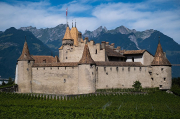
As the effects of climate change continue to reshape traditional winemaking regions, Swedish wineries are emerging as unexpected contenders in the global wine scene.
With longer and warmer growing seasons due to global warming, Scandinavia, once an unlikely candidate for wine production, is embracing new grape varieties and redefining the industry.
Kullabergs Vingård, a pioneering vineyard and winery, stands at the forefront of this movement to redefine Swedish wine. Spanning 14 hectares, most of its vines were planted within the past decade. By 2022, the winery had achieved an annual production of over 30,000 bottles, primarily whites that have garnered international recognition and are featured in esteemed restaurants worldwide.
“While traditional winemaking regions are grappling with challenges, we are gaining momentum,” affirms Felix Åhrberg, a 34-year-old oenologist and winemaker who assumed leadership of Kullabergs Vingård in 2017 after working in vineyards across the globe.
Global Warming Alters Europe's Wine Landscape
The wine industry is profoundly impacted by climate change. Grapevines can withstand heat and drought, and dry farming practices are common in parts of Europe. However, the last decade has witnessed record-breaking temperatures globally, with further warming anticipated. Such changes affect wine production, as even minor shifts in weather can alter the sugar, acid, and tannin content of grapes.
Climate shifts are prompting the relocation of grapevines to new regions. Commercial vineyards have emerged in Norway and Denmark, and others, including those in the American West, are expanding into cooler climates. The United Kingdom, traditionally renowned for its ales, expects a doubling of vineyard area in the next decade to meet the demand for sparkling wines.
“This represents the frontier of winemaking, where the best growth happens on the coolest frontiers,” remarks Felix as he tours Kullabergs Vingård's modern winery.
Southern Sweden has experienced a temperature increase of approximately 2 degrees Celsius over the past 30 years, compared to the preceding three decades, according to data from the Swedish Meteorological and Hydrological Institute. Additionally, the growing season has extended by about 20 days.



































